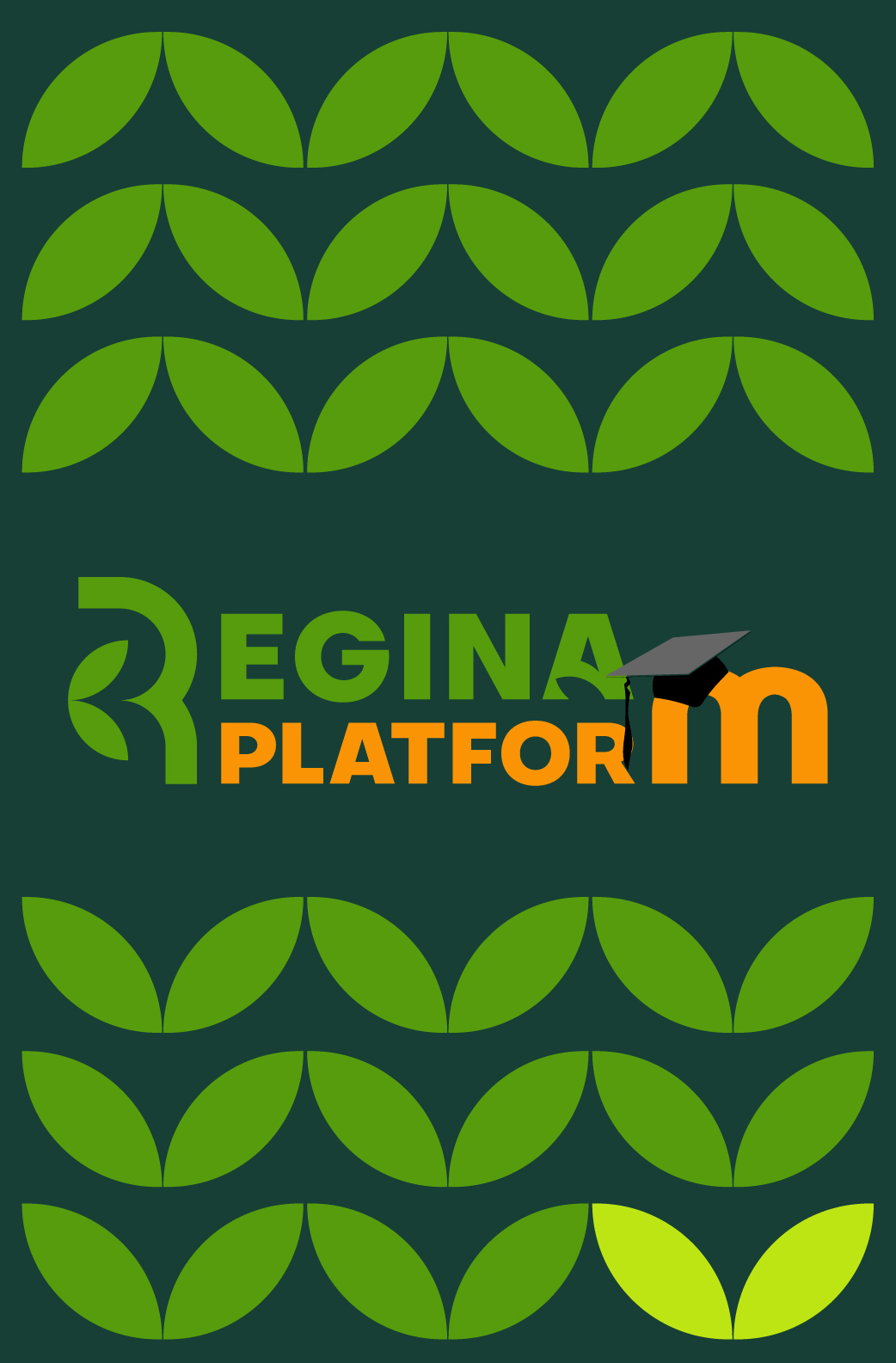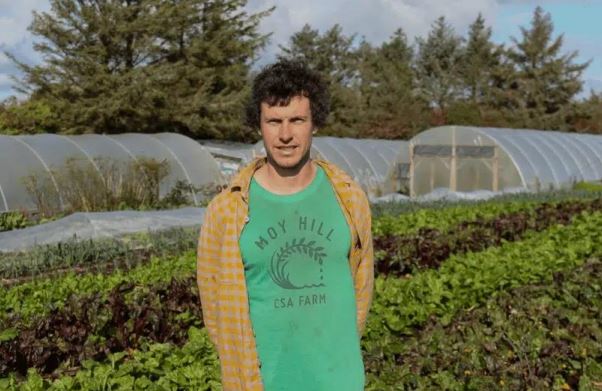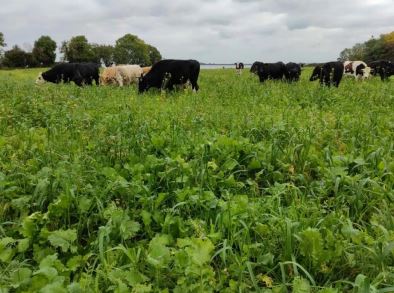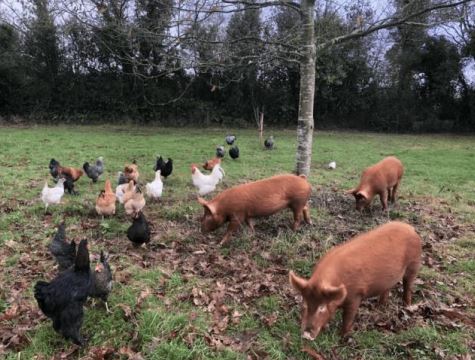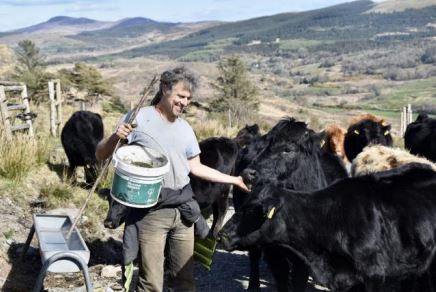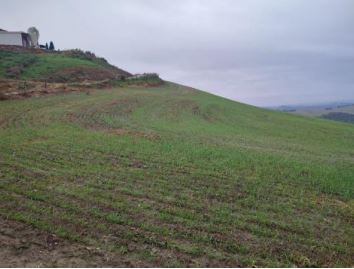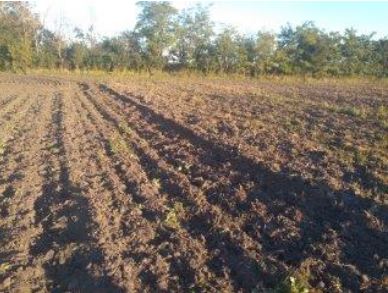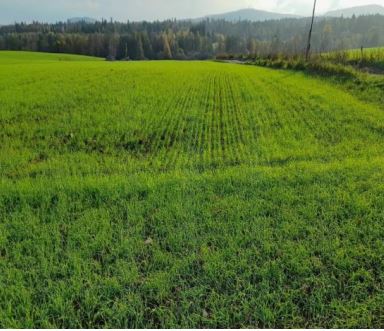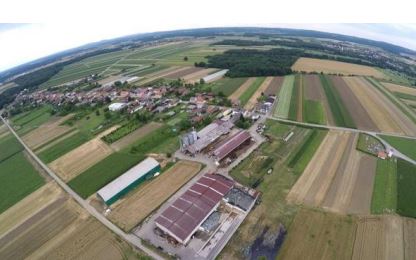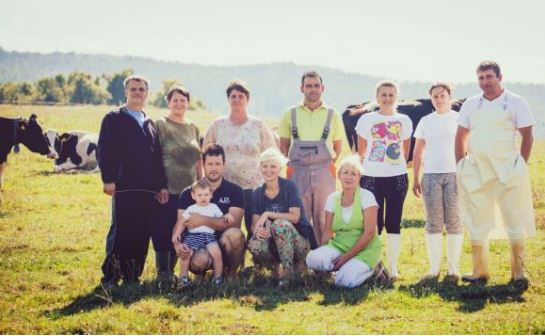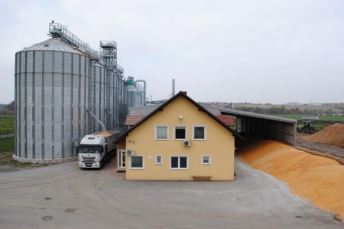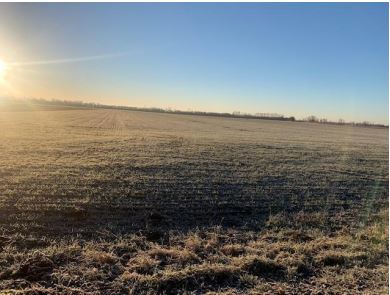Categories
Livestock
Moy Hill Farm
Success Story
Introduction to Moy Hill Farm
Fergal and Sally run an 80-acre mixed regenerative farm on the west coast of Ireland. Fergal grew up on an organic market garden farm in Mayo where he learned about the importance of soil health and farming with nature. After a few years of travelling and surfing around the world, Fergal returned and started his own farm near the surfing town of Lahinch in County Clare, where he now lives with his young family.
Moy Hill Farm contains a mixture of livestock – cows, sheep and hens, and grows about 25 different crops in their “No Dig” Market Garden. They sell a variety of fresh produce at markets and to local restaurants.
Regenerative Agriculture Training
Fergal and Sally began farming regeneratively in 2017 after learning about the methods in a Holistic Management course provided by the Savory Institute, an agricultural research organisation with hubs across the world. Here, they learned how to sustainably manage livestock and how to plan the year ahead to ensure fresh pasture year-round, reducing feed and fertiliser costs. Since then, Fergal has engaged in many trainings, such as a regenerative farming course run by expert Richard Perkins and the Irish National Organic Training Skillnet. He said it is inspiring to learn about farmers from around the world engaging in regenerative agriculture through these trainings and events.
Using Livestock to Regenerate the Land
Fergal described how animals are key for regenerating large areas of land. He views his way of farming as managing ecosystems, protecting and enhancing habitats, and focusing on diversity. Fergal manages his animals so that they benefit, not harm, the environment around them.
Livestock are put into small paddocks and moved daily onto fresh pasture. This rotation cycle, called “mob grazing”, allows for areas of grassland to rest and recover in the periods where they are stockless. Plants are left to “fully express themselves, which allows for the other habitants of the farm, such as insects and birds, to thrive as a result. Fergal believes that he can regenerate hundreds of acres of land with the help of livestock (cows, sheep, poultry) and regenerative management practices.
Regenerative Verification
Every year, Moy Hill farm get an EOV “Ecological Outcome Verification” assessment on their land which verifies that their soils are getting healthier. The EOV surveyors monitor every field on the farm to ensure all environmental indexes are going up. Fergal described how this EOV verification is a simple way of holding regenerative farmers accountable, as it will prove whether they are regenerating their land and making a positive impact.
No Dig Market Garden
Fergal and Sally follow the regenerative practise of minimum disturbance of the soil. Their market garden is not tilled or dug, in an effort to protect the soil’s structure and biodiversity. Up to 25 different crops are grown on their market garden such as salads, kale, beetroot, beans, tomatoes, squash, courgettes, peas, turnips, leeks, onions, and garlic. Their salads are the best seller as local restaurants and shops are in constant demand for fresh, local lettuce.
An Ode to the Past
Fergal described how the way he farms now, is very similar to how traditional farms in Ireland were managed many years ago. Most farms used to have a vegetable garden, poultry, and it was common to have a mixture of livestock, whilst sewing native trees and orchards. Regenerative Agriculture is therefore, as Fergal described, not a “new” concept. It is all about farming in a way that makes sense for the local environment and for the farmers themselves. Fergal and his family benefit from fresh produce and an outdoor lifestyle that is in tune with nature. He describes farming this way as a “labour of love” and “being part of a bigger picture”, whilst also creating a healthy life for himself and his young family. The work of regenerative agriculture never stops, but this makes for an exciting challenge for Fergal.
An Affirming Experience – Farming with Intention
Fergal and Sally believe in “farming with intention”, and that diversity across their farm is key to its health and long-term success. While they are not receiving any financial support to farm regeneratively, indeed the training and EOV certification is costing them money, they are able to grow high quality food and thus market their products at a higher price. Fergal noted how he has been experiencing the ecosystem on his land ‘thrive’ since implementing RA practices, and he spoke about how this is an affirming experience for himself and his family.
LABELS: Ireland, Livestock, Organic, Vegetables/fruits, Green Fertilisation, agroforestry, biodiversity
Mervyn Auchmuty
Success Story
Farming as a Way of Life
Growing up on the family farm, farming for Mervyn Auchmuty has always been his way of life; “I never became a farmer, I was always one”. Now, Mervyn and his father Robert are farming together on their picturesque 400-acre arable (tillage) and mixed livestock farm in County Roscommon.
Minimum Tillage (Min Till)
Mervyn was first introduced to the idea of ‘Regenerative Agriculture’ in 2013, through learning the concept of “minimum tillage” or “min till” (minimum disruption of the soil). The Auchmuty’s land is stoney and therefore difficult to plough, taking many man hours to do so. Removing ploughing from their workload meant less hours ploughing, picking stones, burning diesel, and preparing cropland. The advantages of ‘min till’ were clear for their land. For many, the idea of not ploughing or tilling arable land seems ludicrous, but Mervyn managed to convince his father Robert that it could be a good idea.
Strip-Tilling
And so, the father-and-son duo removed the process of ploughing their soil, and they invested in a “Strip-Till Drill” through the aid of a TAMS (Targeted Agriculture Modernisation Schemes) grant. This Strip-Till allowed the pair to greatly reduce the amount of soil being tilled, only tilling the strips of land where crops were being sown. Mervyn explained the importance of minimum disturbance to the soil for keeping the soil microbes alive, which enhances the nutrient quality of the soil over time. Now the pair also use a “Direct Drill”, which does exactly what it says on the tin; directly drilling the crops into the soil without tilling at all.
Cover Crops
Another benefit to ‘Min Till’ is that most of the soil can remain covered with plants. Mervyn explained how the soil can degrade when there are no plants to cover it; due to factors such as the reduced ability for the soil to absorb carbon and the exposure of the soil to the elements (Sun, Wind, Rain). Therefore, cover crops play a crucial role in the period after crops have been harvested, to cover the bare soil with temporary plants to promote photosynthesis, carbon sequestration and good soil health. The use of cover crops is a practice which many tillage farmers do not observe, yet this changing, increased understanding of the benefits of cover crops through research, and the introduction of government incentives for cover crops are slowly increasing the use of this practice in Ireland.
Improved Root Structure
Mervyn has noticed how the root structure of his crops have improved since he began trialling Regenerative Agriculture practices back in 2013. Plant roots play a vital part in aerating the soil; allowing for better water absorption and providing vital nutrients to the soil.
Natural Fertilisers
The Auchmutys create natural compost with farmyard manure. This process for many farms is now a forgotten practice, as slurry is a more popular modern technique, even though it emits much higher amounts of greenhouse gases (methane, carbon dioxide) and toxic fumes (ammonia and hydrogen sulphide). The creation of natural compost calls for extra time and man hours from the farmers, but the natural benefits are clearly worth it for Mervyn and Robert.
Mervyn has experimented with seaweed and seed washes for naturally fertilising his cropland and seeds. Through his experimentation, he has found that treating seeds before planting leads to longer and stronger root systems and healthier soils.
Part of the Irish Regenerative Agriculture Community
In 2018, Mervyn joined the farmer-run regenerative agriculture group called “BASE Ireland”. Here, farmers share their experiences, ideas, and lessons of advice to other farmers trying out these alternative farming methods. The BASE (Biodiversity Agriculture Soil Environment) group allows farmers to educate each other, chat online, and host knowledge-sharing workshops.
As well as this, Mervyn has engaged in several NOTS (National Organic Training Skillnet) training courses and soil testing initiatives. He has learned a lot from videos on YouTube and through reading internet resources, and he does his part by sharing his knowledge and experience to other farmers through the BASE group.
Engaging in Regenerative Agriculture has kept Mervyn and his father Robert motivated on their farm. Each year, the duo trial new regenerative practices, which helps “keeps it interesting”. Mervyn hopes to continue to learn and trial at least one new regenerative agriculture practice each year.
LABELS: Ireland, Crop Production, Livestock, Green Fertilisation, Biodiversity, Biodynamic Agriculture, Crop Rotation, Min Till
John Mchugh
Success Story
John McHugh is a nature-friendly, registered organic farmer from Co. Laois, who inherited a 95-hectare farm from his parents in 2001. He has a modest herd of 60 dairy cows, along with a small beef herd, hens and pigs, whom he frequently integrates together as seen in the image below.
The Beginning of John’s Regenerative Journey
In 2014, John needed a change. He wanted to be free from debt and for his farming to become more resilient; both economically and environmentally. He no longer wanted to “blindly follow advice”, and he was motivated to discover less intensive farming methods. So, he began the gradual process of reducing his herd size and has gone from a herd of 160 in 2014 to 60 in 2023.
John believes that there is not much space for nature in the conventional system due to the stringent rules and high costs. So, regenerative agriculture was an exciting opportunity for John to make a real change, on his own terms. John believes that dairy farmers can be too heavily focused on trying to have as many cows as possible, while maximizing output. He explained how this can be a vicious cycle of higher costs and inputs, as he came to realise from his many years of conventional farming.
100% Forage Based Feed
Now, after farming more regeneratively for almost 9 years, John’s land has grown incredibly resilient. For example, John has not been feeding any grain feed to his cows and other cattle on the farm since 2020, all animals are 100% forage fed (predominantly grass). His pastureland is plentiful, and he makes his own silage and hay for indoor feeding. John explained how his animals’ forage-based diet allows for the end products (meat and milk) to be richer in omega 3 fatty acids. Creating his own feed allows for a healthier, more cost-friendly, and generally more sustainable product as it is all produced on-farm through organic growing methods.
Keeping the Cattle Out Year-Round
Unlike most other Irish dairy farms who bring their cattle in for the winter, John can keep his cattle out year-round as his herd is small and his pasture is abundant and resilient to the Winter weather conditions. He puts this resilience down to his regenerative farming methods; with stronger soils and healthier plant growth. Of course, he mentions, if the weather becomes harsh then he will bring the cattle indoors, and indeed, his winter milking cows are kept indoors for ease.
Becoming Friends with Shrubs and Trees
John is engaging in the process of semi-rewilding areas of his land through engaging with Agroforestry and growing Scrubland. He keeps the cattle out of these areas until the land has matured enough for them to forage, as seen in the image below. Allowing his dairy cows to feed outside of grassland pasture is unique in the Irish dairy farming landscape.
John believes Regenerative Agriculture is “highly contextual”, and that farmers must find the practices that work for them, and their land. John holistically grazes his cattle on mature, diverse grassland. Paddocks are not over-grazed, and are given time to rest and regrow after grazing.
Welcoming in the Community
John has allocated a section of his farm for the community to keep small allotments and grow their own produce. This community farm is planted with a mixture of native trees and vegetables in the hopes of forming a Forest Garden with plentiful fruit and nut trees. For John, the community farm is not about profit, it’s about social exchange and people working together.
Biodiverse Pastureland
John has multispecies swards of a variety of native grasses and herbs that lead to his fields looking like colourful meadows in the Spring and Summer. He allows his grass to go to seed, which has exploded the biodiversity and greatly increased the number of pollinators.
Saying No to Chemical fertilizers
John believes that you can’t claim to be regenerative if you are using nitrogen or phosphorus fertilisers, as they undermine the carbon and natural diversity of our swards. Indeed, these fertilisers have been known to reduce soil biodiversity whilst leading to high levels of run-off and subsequent water pollution in Ireland. John noticed how when other farmers were struggling with drought and wet weather conditions nearby, his grass was continuously growing strong, and he believes this is due to improved water retention in his soil that has been enabled through his years of regenerative practices.
Quality Produce, Improved Animal & Financial Health & Continuous Improvement
John sells his dairy to a local organic yoghurt producer called Glenisk. While organic premiums were hit hard this year, he hopes to receive a higher price for his goods in the coming years. Through regenerative farming, John has found financial resilience, a reduced workload, huge improvement in his animals’ health, and more time to spend with his young family. John says that regenerative agriculture is a constant process, with continual tweaking and reassessments of practices necessary.
LABELS: Ireland, Livestock, Organic, Dairy, Green Fertilisation, Agroforestry, Biodiversity
Derry Duff Farm
Success Story
Derry Duff is a 54-hectare farm, established in 2008 and located by the wild Atlantic Ocean. Steve and Claire integrated regenerative practices into their farm from the start and attained organic status in 2010 due to the mandatory 2-year conversion period. Regenerative Agriculture is similar to Organic Farming in many ways, as it uses no chemical inputs such as synthetic fertilizers, pesticides or herbicides. Regenerative Farming is a term for a range of sustainable farming practices that farmers can implement on their land, with a large focus on improving the health of the soil, biodiversity, nutrient cycling, water quality and reducing greenhouse gas emissions.
Derry Duff is unlike other Irish farms, as their main crops are organic Blueberries and Aronia Berries, both grown for their nutritional properties. Once harvested, the berries are made into health food products and drinks. The rugged mountainous landscape of the Derry Duff West Cork farm is unique, filled with native species such as heather, birch and alder. Steve and one other worker permanently farm, with temporary volunteers coming to stay and help for a few months at a time.
Derry Duff farm is certified with the Irish Organic Association and they abide by a range of sustainable farming practices. Instead of using chemical nitrogen fertilizer, clover and herbs have been mixed into grass swards to fixate nitrogen naturally. They use no pesticides or herbicides so weeding is done manually. Native trees and shrubs have been planted around the edges of several small ponds, to act as an absorption layer between the paddocks and the water, reducing the risk of pollution to the water.
Derry Duff is home to many animals, with a small herd of 18 organic dexter cattle who roam the wild mountainous landscape alongside the chickens. Derry Duff excellently integrates animals with the land, ensuring that their animals benefit, rather than harm, the environment. The farm also has a Tree Nursery and Steve and Claire are experimenting with Agroforestry; whereby native trees are planted within grazing land to provide nutrients for the soil and shelter for the animals.
An apple orchard of 80 trees is inhabited by free range chickens, who roam around the young apple trees. This integration of animals with trees is a feature of Regenerative Agriculture. For example, the chicken scratches around the radius of the trees, keeping the area clear from weeds, as well as providing precious natural fertilizer!
Steve and Claire’s goal since starting their farm was to make it more beautiful, and to do so in a way that was in harmony with the hills and natural landscape. Steve’s knowledge of regenerative agriculture was entirely self-taught and refined through trial-and-error. Steve believes that much of regenerative farming is “common sense”, and he enjoyed this trial-and-error that came with implementing regenerative practices, coming from a scientific background himself.
Steve has seen a variety of benefits from Regenerative Agriculture, such as:
- Economic benefits: they can market their products as higher quality than standard.
- Land management: the cattle aid in the management of the tricky hilly landscape.
- Improved soil: the Aronia plant has deep roots that penetrate the clay subsoil which promotes nutrient cycling and regenerates the soil.
- Increased Biodiversity: due to diverse habitats, wildlife corridors, and no destructive farming practices on the farm.
There were a few downsides for Steve, such as the manual work from weeding by hand and a lack of funding for Regenerative Agriculture practices. Overall, Regenerative Agriculture is working excellently for Steve and Claire’s farm, and they intend to explore further regenerative practices into the future.
LABELS: Ireland, Livestock, Fruits, Organic, Green Fertilisation, Biodiversity, Agroforestry
Lanini’s farm
Success Story
The Giuseppe Lanini’s Farm is located in Mucigliano, a small municipality of Asciano in the province of Siena (Tuscany region, Italy). The farm has a surface area of 200 ha with 1 person as permanent staff and 2 people as temporary staff. In addition, the farmer works as a contractor and can cultivate 600 ha. They are cultivating the following crops: durum wheat (Triticum durum L.), barley (Hordeum vulgare L.), and different kind of clovers, mainly squarrosum and alexandrinum. Besides, the farm also includes livestock with almost 700 sheep. They apply soil conservation practices overall on the farm surface. Specifically, they carry out no-tillage management of the soil. They usually execute a four-year rotation, settling clover as the first-year crop followed by three-year cereals. In addition, they manage legumes with cover crop purposes. Anyway, a part of the sewage produced by sheep is used as fertilizer, while the other is sold.
The previous practices have been used from 2014 to the present (2022). They started to apply no-tillage because they had a very high cost for cultivation and low revenues from the sale of agricultural products. He received training on the practice of soil conservation from the company that sold him the sod seeding machine. However, he did not receive any financial support to start soil conservation practices. After the application of the soil conservation practices, he experienced a similar grain yield compared to the previous years, but with a lower workload and lower costs, in terms of fuel. Additionally, better soil quality was obtained in terms of fertility as assessed by the amount of organic matter and the number of earthworms in the first soil layers. Because of the lower workload, he was able to cultivate more land as compared to the previous years. On the other hand, he pointed out the diffusion of weeds, especially Lolium, overall the field; he solved the problem using Lolium as hay and applying the pre-emergence herbicide. Altogether, the farmer is very happy to apply soil conservation practices and he doesn’t want to change anything.
LABELS: Italy, crop-production, livestock, no-tillage
Farkasdiné Fekete Vilma
Success Story
The personality and farm of Farkasdiné Fekete Vilma significantly contributes to the development of the agricultural sector in Hungary. The farm, located in the village of Mezőörs, plays a prominent role in Győr-Moson-Sopron County. Farkasdiné Fekete Vilma is an extremely dedicated and responsible farmer.
The farm boasts a large land area, spanning 140 hectares. It is operated as a family farm, with her husband and sons, all of whom are agricultural engineers, and they do not employ seasonal labor. Vilma understands that farming is not an easy task and that proper manpower is essential for maintaining a successful farm. It seems that through effective labor organization and efficient resource utilization, she manages her farm successfully.
Over the past 5 years, the farm's activities have focused on arable crop cultivation and livestock breeding. During this period, they have grown several types of crops, including wheat, rapeseed, barley, sunflowers, corn, phacelia, and they also have 43 hectares of pasture. In terms of livestock, they raise and breed pigs and sheep. In addition, to add diversity, there is a small orchard on the farm. This diversity demonstrates that Vilma and her family understand the advantages of economic diversification in agriculture, which leads to a more secure and stable farming operation.
During the interview, Vilma revealed that her farm practices regenerative agriculture (RA) techniques. Regenerative agriculture is an approach aimed at restoring soil and the environment while promoting sustainable farming practices. It is crucial for farmers to recognize the benefits of RA, as it can have a significant long-term impact on agricultural production and the environment. Vilma and her family have been applying these practices for years, across the entire farm. RA practices include the use of organic manure, beneficial soil bacteria, cover cropping, crop rotation, and the planting of hedgerows. These measures not only increase the farm's efficiency but also contribute to soil quality improvement, prevention of soil depletion, and successful crop cultivation.
In order to implement RA practices, Vilma and her family not only learned from their parents but also gathered knowledge from various sources. While they didn't participate in specific RA training, they continuously educate themselves on issues affecting their farm, read agricultural literature, and consider the opinions of experts. One of her sons even obtained a Precision Agriculture engineering degree. This shows that the farmers are open to absorbing new information and constantly strive to improve their farm.
Thanks to RA practices, farmers also contribute to environmental protection and sustainable farming, which can have long-term benefits for both their farm and the environment. However, it's important to note that agriculture is always fraught with challenges, and the introduction of regenerative agriculture is not always easy. To overcome potential obstacles, they likely cooperated closely, relied on each other's support and experience.
Due to RA practices, environmentally friendly and sustainable farming, they contribute to nature conservation and biodiversity preservation. Furthermore, the restoration and preservation of soil fertility can lead to sustainable agricultural production in the long run, which is critical for the future success of the farm.
Vilma and her family seem satisfied with RA practices and intend to continue implementing them in the future. Their commitment to environmentally conscious farming and the positive results achieved on their farm reinforce their belief that they made the right decisions when they embraced regenerative agriculture. However, they note that they do not plan to change their existing RA practices or the range of crops they cultivate.
The case study of Vilma Farkasdiné Fekete is an excellent example of how sustainability and ecological approaches can bring significant benefits to the agricultural sector. The adoption of regenerative agriculture allows farmers to responsibly care for natural resources and contribute to environmental protection. Sharing and spreading such best practices can contribute to the broader development of the agricultural sector and the promotion of environmentally conscious agriculture.
In summary, the REGINA case study is an inspiring story of how agriculture can be improved and production can be made sustainable through the introduction of elements of regenerative agriculture. The collection and sharing of such good practices can contribute to the broader development of the agricultural sector and the promotion of environmental protection. The example of the REGINA farm proves that regenerative agriculture is not only a more sustainable farming method but can also be the key to the long-term success of agriculture.
LABELS: Hungary, crop production, livestock, biodiversity
Farm Penko: Nurturing Regenerative Agriculture
Success Story
Farm Penko, guided by owner Matej Penko, is a promising entity in Slovenia's Notranjska region near Postojna. Spanning 53 hectares, the farm's pursuits encompass agriculture, cattle breeding, and nascent regenerative practices.
Matej, a young farmer with formal agricultural education, steers the farm's journey towards regenerative agriculture. A recent adopter, he seeks to bolster his understanding in this sphere, acknowledging gaps in his schooling.
In his two years of regenerative practice, Matej implements minimal tillage, green flooring, hedge preservation, and a three-year crop rotation. Barley, grass clover mix, hay, and alfalfa flourish under these principles. His impetus arises from cost reduction and hedge maintenance incentives advised by agricultural consultants. Ministry of Agriculture support further bolsters his efforts.
Benefits of regenerative agriculture, including reduced soil cultivation costs due to the absence of plowing and financial support, are evident to Matej. However, challenges arise from heavy soil, limited arable space, and crop-damaging wildlife. Matej's solutions involve creative land consolidation and diligent soil enrichment through manure application.
Farm Penko's trajectory remains fixed on regenerative agriculture, driven by its tangible benefits and Matej's contentment with this evolving farming methodology.
LABELS: Slovenia, livestock, crop-production
Farm Štefan Cigüt: Driving Regenerative Agriculture in Pomurska
Success Story
Farm Štefan Cigüt, led by Štefan Cigüt Jr., shapes agricultural excellence in Slovenia's Pomurska region near Moravske Toplice. Encompassing 380 hectares, the farm excels in crop cultivation and livestock breeding.
Štefan Cigüt Jr.'s dedication to regenerative agriculture spans a decade. The farm's diverse produce includes corn, wheat, barley, sunflowers, soybeans, alfalfa, clover and grass mixtures, triticale, and pumpkins.
Regenerative principles were adopted to amplify soil fertility, bolster structure, and augment humus content. Vitality preservation and sustainable farming practices spurred this transition. Štefan's education on regenerative agriculture via the Slovenian Association for Conservation Agriculture enriched his approach.
The farm thrives with continuous plant coverage or residue, culminating in enhanced soil quality and heightened organic matter in the upper strata. Minimal soil interventions lead to reduced machinery passages and minimized compaction—a cornerstone of their success.
Štefan underscores that regenerative agriculture's impact extends throughout the agro-ecosystem. Permanent practice, implemented over years, ensures its effectiveness. The farm's satisfaction with these techniques underscores their adaptability to agricultural needs.
Farm Štefan Cigüt exemplifies the harmonious synergy of progressive practices and farming sustainability, marking a transformative journey in the Pomurska landscape.
LABELS: Slovenia, livestock, crop-production
Farm Žgajnar: Leading Organic and Regenerative Agriculture
Success Story
Farm Žgajnar, overseen by Tone Žgajnar in Slovenia's Primorsko-Notranjska region, covers 316 hectares dedicated to animal husbandry and cereal cultivation. The farm's focus on organic practices is underscored by its milk, beef, and pork production, predominantly via wheat fields using regenerative techniques.
Embracing regenerative agriculture for over a decade, the farm employs methods such as direct sowing, crop rotation with grass clover mixtures, seeding grasses, and preserving biodiversity through unmown meadow sections. Green fertilization is practiced alongside late mowing for seed production.
Tone Žgajnar, reflecting on the journey, cites the pivotal reasons for adopting regenerative practices: heightened soil fertility, diminished humus leaching, and lower production costs. The transition was propelled by experiential learning from professional excursions, leading to the successful implementation of regenerative techniques.
The positive outcomes of regenerative practices are evident. Over the decade, soil organic matter has increased, contributing to sustainable agricultural practices. Although challenges persist with weed management due to organic principles, the farm remains steadfast in its commitment to regenerative methods.
Despite the absence of financial support for regenerative agriculture, the farm's success and satisfaction serve as motivation for its continued application. Farm Žgajnar stands as a testament to the tangible benefits of regenerative and organic farming, exemplifying the harmonious balance between sustainability and productivity.
LABELS: Slovenia, livestock, dairy, organic
Farm ŽIPO Lenart: Leading Regenerative Agriculture in Slovenia
Success Story
Farm ŽIPO Lenart, under CEO Miha Krajnc's leadership, is a trailblazing agricultural enterprise in Slovenia's Podravska region. Spanning 860 hectares, the farm pioneers regenerative agriculture to grow crops and support livestock. The farm primarily produces corn, wheat, barley, oilseed rape, soybeans, and occasionally other crops. About 26 hectares follow organic practices, contributing to feed for beef cattle and pigs. The farm annually breeds around 1,400 cattle and 3,500 pigs.
Beyond traditional farming, the farm engages in grain purchase, storage, drying, and agrobiomass processing. It produces animal bedding and calf feed, employing 11 permanent and 10 seasonal workers.
A standout aspect is the farm's commitment to regenerative agriculture for eight years. Beginning in 2015 with minimal tillage, the approach involves soil loosening to 20 cm depth, saving energy, time, and improving soil quality. Despite benefits like reduced labor and enhanced soil structure, challenges like weed and pest management arise. However, the farm remains dedicated, focusing on solutions and refining its regenerative practices.
Farm ŽIPO Lenart stands as a beacon of sustainable, efficient farming, embodying innovation, diversification, and a profound commitment to regenerative principles.
LABELS: Slovenia, livestock, crop-production
Bóna Szabolcs, Rábapordány Agricultural Zrt.
Success Story
Founded in 2000, Rábapordányi Agricultural Zrt., located in the heart of Rábaköz, covers an area of 1,100 ha. The main profile of the economy is livestock breeding. Bóna Szabolcs farmer started introducing regenerative agriculture practices in part of their territory in 2012, which he learned by watching American video materials. The farm has 82 permanent employees and 3 seasonal workers. The farmer was elected as the Animal Breeder of the Year in 2022.
The main activity of the farm is animal breeding (dairy cattle breeding, pig breeding, pig fattening), their crop production is intended to provide the supply of bulk and fodder for livestock through the production of various arable crops: winter fodder peas, soybeans, wheat, spring barley, silage corn, rye, alfalfa.
On the one hand, they started using regenerative practices in their farm to protect the soil, as it was clear from their soil test results that the humus content of the soil decreased even with organic fertilization. They wanted to reverse this process, and they succeeded! On the other hand, due to the significant increase in cultivation costs. They were looking for ways to reduce costs without a significant decrease in yield.
After legumes in the crop rotation, they try to reduce tillage to zero. Basically, they try to use as little soil disturbance as possible after each plant. They try to provide soil cover for as long as possible, either with mulch or by using cover crops. Cover crops are sown after the summer crops, in front of their spring-sown crops. They are also experimenting with cover crops in front of autumn cornfields of an experimental nature. Termination is carried out in early spring. Rye is sown in the fall, combined with beech, which is harvested as hay, then the area is organically fertilized, which is worked shallowly into the soil and sown with corn. In the year 2022, direct seeding after rye was also tried on an experimental basis, encouraged by the results, in 2023 the entire second sowing was carried out without cultivation, with a direct seeding machine.
Depending on the results, they would like to continue the practices of regenerative agriculture, as Rábapordányi Agricultural Zrt. tries to farm in an environmentally conscious way. It strives to reduce its energy consumption. During its operation, it complies with the legal framework for energy efficiency, which has recently increased in value both from the point of view of environmental protection as well as economics.
An important aspect of their farming is carbon sequestration (increasing the humus content), as they see the only real carbon sequestration activity in crop cultivation with correctly performed tillage.
LABELS: Hungary, livestock, crop-production
